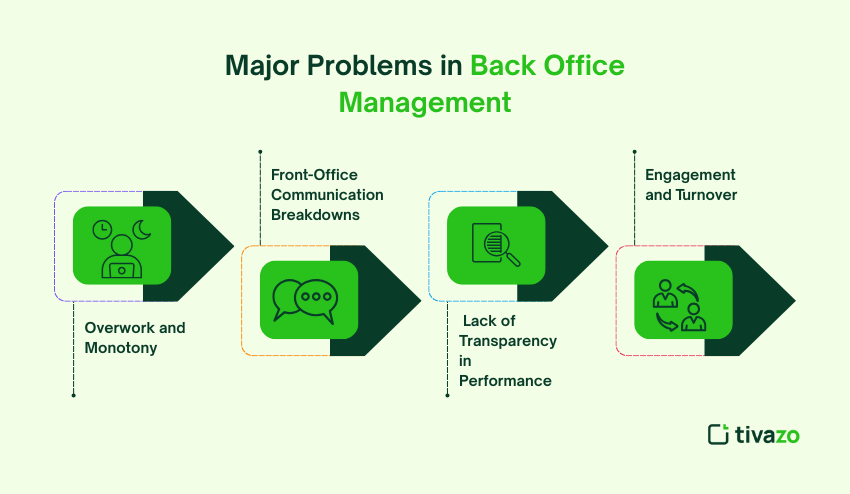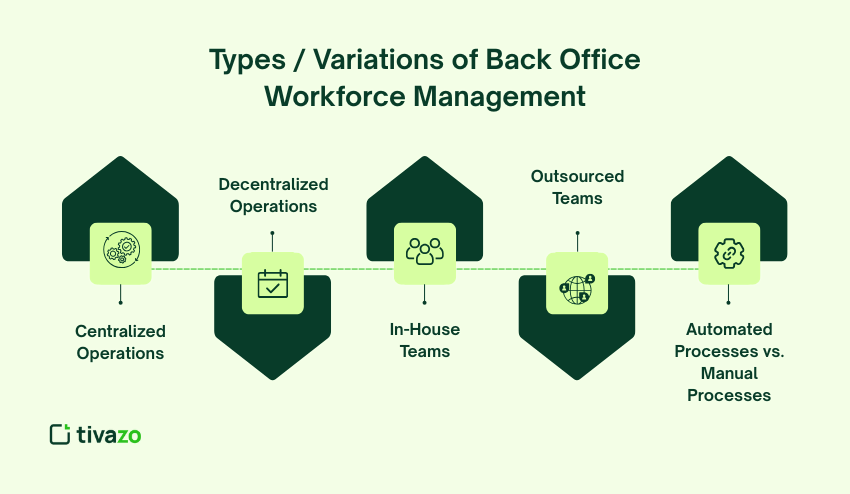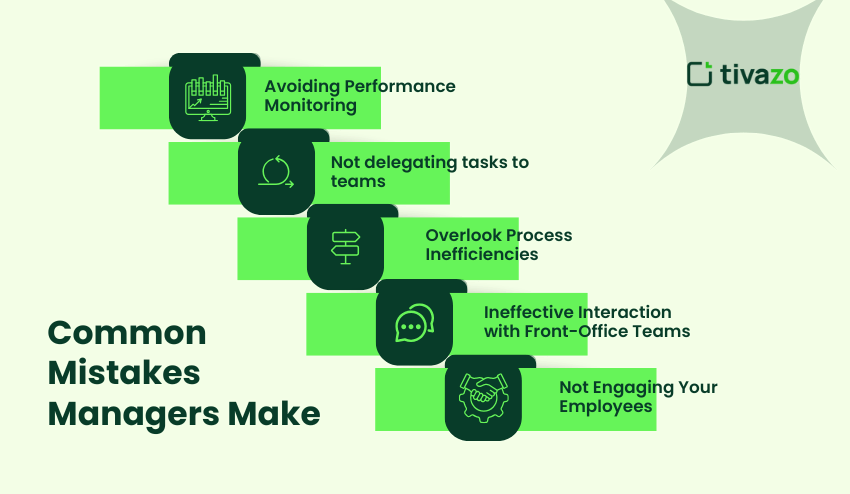Managing the back office teams is an important task that managers need to undertake, but it is usually unrecognized. An effective back office workforce management will provide a smooth flow of operations, proper processing, and robust support of front-office functions. In its absence, groups may experience inefficiency, mistakes, and lack of interest.
Other core functions carried out by the back office workers include payroll, finance, human resources, and administrative functions. The consequences of the poor management of these functions are experienced throughout the organization, including slow decision-making and low customer satisfaction.
This paper will discuss what back office workforce management is, the pitfalls that managers often encounter, how they can be addressed and what the managers should not do. With these tips in mind, managers are able to develop effective, engaged, and productive back office teams to spearhead the overall success of the business.
What is Back Office Workforce Management?
Back office workforce management is the process of planning, coordination, and management of employees that manage the internal affairs of an organization. These teams handle such functions as finance, HR, administration, IT support, and compliance. Good management will see tasks being done correctly, in time and according to the business objectives.
Back office managers are concerned with process optimization, performance, and resource efficiency. Back office employees, unlike front office teams, are the ones who offer the much needed support that keeps the business going on well.
This function is important to understand as any mistakes or inefficiencies in the back office can percolate across the organization resulting in delays, higher costs and lower employee and customer satisfaction.
Front Office vs. Back Office Workforce Management
Although both methods are the best ways to maximize employee performance, they are dealing with entirely different operational requirements.
Front office workforce management is concerned with customer-facing jobs such as sales teams, call center employees, and retail employees. Real time responsiveness, managing unpredictable customer volumes, and ensuring quality of service on-the-fly is the priority. Measures revolve around customer satisfaction ratings, average handle time and first call resolution.
Back office workforce management focuses on supporting functions with process efficiency, accuracy and compliance. Employment is usually project oriented or in cycles as opposed to demand orientation. Measures of success are error rates, processing time, backlog reduction, and meeting internal deadlines.
The flexibility of the schedule also varies greatly. Front office teams are usually sensitive to coverage schedules to ensure service levels. Back office jobs usually permit greater flexibility in terms of when work is done provided that deadlines are met and quality is not compromised.
Most organizations have integrated platforms that control front and back office functions. This establishes synergies in data flow across departments, in forecasting, and in cross-functional working.
Why Back Office Workforce Management Matters for Managers and Owners
The Real Cost of Poor Back Office Management
Inefficient back office operations drain your budget in ways that rarely show up in quarterly reports until the damage is done. Here’s what poor management actually costs you:
Direct Financial Losses:
- Manual data entry in HR and payroll costs $4.78 per entry on average
- Mid-sized companies waste millions annually on repetitive manual processes
- One multinational firm paid nearly $33 million in fines for delayed transaction reporting
- Excessive overtime from poor scheduling inflates labor costs by 15-25%
Employee-Related Costs:
- 67% of employees feel overwhelmed by repetitive manual tasks
- Only 45% of employees clearly understand their job expectations
- Burnout and disengagement lead to turnover rates 30-40% higher than industry averages
- You’re paying professional salaries for clerical work when teams spend hours on spreadsheets
Operational Impact:
- Process bottlenecks delay critical business decisions
- Compliance gaps expose you to regulatory penalties
- Poor workload distribution creates feast-or-famine scenarios
- Some team members work excessive overtime while others have unused capacity
Business Benefits You Can Measure
Strategic back office workforce management delivers concrete improvements that directly impact your bottom line. Here’s what you can expect:
Cost Reduction (20-40% savings):
- Eliminate overstaffing and reduce unnecessary overtime
- Automate low-value repetitive tasks
- Prevent expensive last-minute staffing adjustments
- Negotiate better vendor pricing with improved forecasting and longer lead times
Productivity Improvements (25-35% increase):
- Employees spend more time on value-adding activities
- Automated scheduling eliminates hours of spreadsheet manipulation
- Self-service tools reduce management overhead
- Faster task completion through optimized task allocation
Employee Retention (15-30% improvement):
- Flexible scheduling improves work-life balance
- Better workload distribution prevents burnout
- Increased autonomy over schedules boosts job satisfaction
- Reduced firefighting creates more sustainable work environments
Compliance Risk Mitigation:
- Automated monitoring ensures SLA adherence
- Clear accountability trails for audit purposes
- Real-time alerts prevent regulatory violations
- Protection from six-figure fines and reputational damage
Real-Time Visibility:
- Spot issues as they develop, not weeks later
- Desktop analytics show exactly what teams are working on
- Identify process inefficiencies immediately
- Intervene before small problems become crises
The return on investment typically appears within six to twelve months. After the initial implementation period, the ongoing benefits compound as you refine processes based on accumulated data and employee feedback.
Major Problems in Back Office Management.
Managers have special challenges when managing back office workers. The first step to improving performance and efficiency is to identify these challenges.

1. Overwork and Monotony.
Back office jobs usually incorporate mundane activities like entering data, processing payrolls or creating reports. Employees may get overworked and bored without appropriate automation or delegation.
Example: A financial department manually balances hundreds of transactions per week. Without workload balancing or automation, the errors grow and the deadlines are missed.
2. Front-Office Communication Breakdowns.
Back office teams are usually working in the background, and this may create misalignment with front office departments. Communication delays can influence service or decision-making.
Example: HR does not inform the front-office team of new policies, which causes inconsistency in enforcement and confusion among the employees.
3. Lack of Transparency in Performance.
For work that is direct or not customer-facing, individual work and productivity are challenging for managers to observe. It is not clear who is underperforming and who is actually performing well.
4. Engagement and Turnover
Disengagement may start due to a stressful environment, lack of recognition, or lack of career guidance. Turnover is disruptive as processes are interrupted and the cost of training replacement employees is incurred.
Example: A data entry team suffers from a 25 percent turnover each year because the work is repetitive and there is not growth path.
Types / Variations of Back Office Workforce Management
The back office workforce management can take a number of shapes as per the structure and management of the operations. The awareness of these differences may help managers select the best type of efficiency and interaction with employees.

1. Centralized Operations
When the back office workforce management is done centrally, all functions are aligned at a central location. This allows normal operations and monitoring of performance.
Example: Company HR, payroll and finance departments are located in one central office where policies and reporting are standardized.
2. Decentralized Operations
Decentralized management spreads back office functions to a place or a group of people beyond one. It might make it more flexible, but it requires proper communication and supervision to promote consistency.
Example: Regional offices manage their payroll and administrative operations and they should be in constant contact with the central office.
3. In-House Teams
The back office staffing teams are internal and are comprised of full-time company employees. This provides managers with more control over process, training and performance.
Example: An organization contains an IT support team to maintain all internal software and hardware issues.
4. Outsourced Teams
Other firms outsource back office functions to external firms in order to cut costs or access expertise. This can be effective but it needs to be handled carefully with a keen eye on the vendor.
Example: A company contract an expert to process payrolls to save time and minimize errors.
5. Automated Processes vs. Manual Processes.
Back office workforce management can use manual processes or automated processes. Automation is more accurate, scalable, and fast, but manual processes can introduce errors and slow processes.
Example: Processing invoices with accounting software instead of spreadsheets will remove errors and enable employees to engage in more valuable activities.ng instead of manual spreadsheets reduces errors and frees employees for higher-value tasks.
9 Proven Strategies for Effective Back Office Workforce Management
Strategy 1: Adopt Data-Driven Workforce Analytics.
Stop managing by gut feeling. Monitor task completion, schedule compliance, usage of application, and workload allocation. The tools such as ActivTrak and Power BI identify bottlenecks in a few weeks. A finance department found that 30 percent of its time was waiting to get a response out of the system and then it began to upgrade its infrastructure to recover the time.
Strategy 2: Maximize Schedule Compliance and Capacity Planning.
Adjust available capacity to real demand through analysis of past trends and determination of periodic peaks. Allow 10-15% capacity overload. Proper forecasting will do away with scrambling to staff at the last minute and will save 25-35% in overtime.
Strategy 3: Automate Repeat Tasks.
Pay attention to high volume, low complexity activities such as data transfers, report generation, and approval processes. Assuming 5 hours saved weekly with automation at 30/hour, then 7,800/year. Majority of automation tools recover in 3-6 months.
Strategy 4: Have Effective Performance Measures.
Establish KPIs in four categories: efficiency (tasks per hour), quality (error rates), compliance (SLA compliance), and engagement (turnover rates). Establish benchmarks prior to change, monitor trends over time and make metrics visible. Pay attention to the indicators that employees can manipulate in their day-to-day work.
Strategy 5: Empower Employee Self Service Tools.
Provide employees with the ability to change shifts, request time off and schedule visibility. Employees who have schedule flexibility are 20-30 times more satisfied with their job and managers save 5-10 hours per week on coordination.
Strategy 6: Standardize Processes within Teams.
Map existing processes, detect differences, and state best standard practices. Engage employees in the development of standards, test with small groups, and train in implementation. Standardization provides the basic levels of uniformity with some toleration to special conditions.
Strategy 7: Take Advantage of Real-Time Monitoring.
Display dashboards with status of current workload and SLA risk alert systems. Establish intervention levels: when the backlog is more than 24 hours, redistribute work. Real-time visibility makes you a reactive firefighter and a proactive manager.
Strategy 8: Invest in Focused Training and Development.
Recognize areas of skills deficiency, do away with single points of failure and introduce cross-training initiatives. Companies spending 3-5 percent of labor expenses on training achieve higher productivity returns than the investment, and 25-40 percent higher retention.
Strategy 9: Nurture Cross-Functional Cooperation.
Open silos by holding frequent cross-departmental meetings, sharing documents, and collaborating on improvement projects. Work in process-based collaboration tools, such as Slack or Teams, rather than department-based. Cross-functional work saves 20-30% of redundant efforts.
Common Mistakes Managers Make in Back Office Workforce Management
Even seasoned managers are prone to traps that make back office workforce management less efficient and less engaged with their employees. These errors need to be identified to enhance performance and employee happiness.

1. Avoiding Performance Monitoring.
Managers who do not monitor productivity or errors are unable to detect underperformance or inefficient processes.
How to prevent: Introduce KPIs and frequent performance reviews to make the process accountable and improve it all the time.
2. Not delegating tasks to teams.
Allowing a small number of employees to do too much work results in burnout and errors, and others will go to waste.
How to prevent: Share workload equally, assign tasks to others, and employ workload monitoring devices.
3. Overlook Process Inefficiencies.
Continued use of the old or manual processes minimizes productivity and increases the error rate.
How to Prevent: Regularly review processes and use automation or simple processes whenever possible.
4. Ineffective Interaction with Front-Office Teams.
Clients facing functions are often supported by back office teams. Poor communication may lead to poor decisions, mistakes, or poor quality of services.
How to Prevent: Establish organized communication and frequent syncs with front-office teams.
5. Not Engaging Your Employees.
Not rewarding accomplishments or not providing development opportunities may lead to disengagement and attrition.
How to Mitigate: Reward accomplishments, and provide training and opportunities for the back office staff to take a step upwards in their career.
Conclusion
Managers who desire their teams to perform efficiently, accurately and in line with organizational objectives need effective back office workforce management. Through insight into problems, the identification of pitfalls, and the use of systematic plans, managers can turn their back office activities into a smoothly running support system of the whole organization.
By defining roles, monitoring performance, automating repetitive work and creating engagement, managers not only enhance operational efficiency, but also increase morale and decrease turnover. Properly run back office teams will deliver precise information, back front-office operations, and allow improved business decision-making.
Begin by evaluating your existing procedures and applying the seven steps model. Even minor changes in the management of the back office workforce can result in substantial productivity, employee satisfaction, and business performance.




